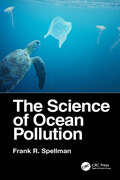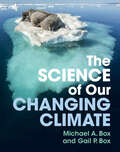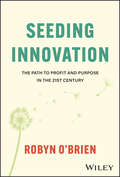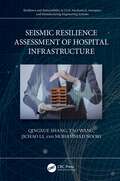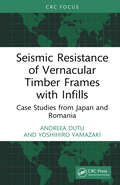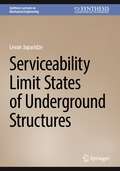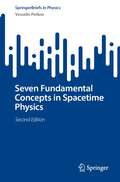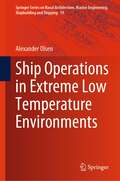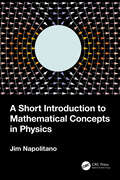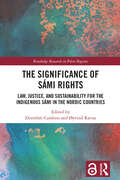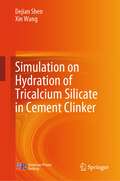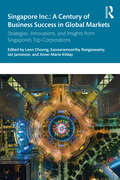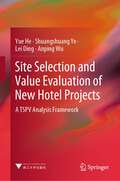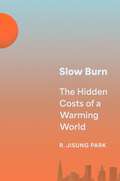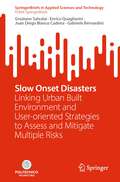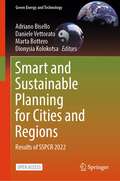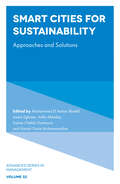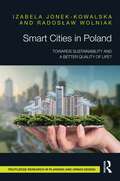- Table View
- List View
The Science of Ocean Pollution
by Frank R. SpellmanThe marine environment supports nearly half of the universal primary production, and a great share of which drives global fisheries. The Science of Ocean Pollution is written and presented in the author’s characteristic conversational style and provides comprehensive coverage of the current situation regarding pollution in the world’s oceans. Even though our welfare is intricately linked, interconnected with the sea and its natural resources, humans have substantially altered the face of the ocean within only a few centuries. The face of today’s sea is quite apparent, obvious and visible; it floats. This book examines pollution runoff, plastics, oil spills, and other pollutants that float in our seas as well as methods to best remediate these issues.
The Science of Our Changing Climate
by null Michael A. Box null Gail P. BoxThis compelling textbook provides a broad overview of the science underpinning our understanding of our climate, and how it is changing. Presented in clear and accessible language, and requiring only minimal algebra, it enables students to understand how our planet “behaves” under “normal conditions” and how human activity has moved us away from that normal. It walks the student comprehensively through the basic science, including how greenhouse gases absorb radiation and, crucially, a chapter on aerosols, major players in climate change. Diverse case studies and examples illuminate the impact and connections to real world events while review questions and exercises consolidate knowledge. Including the latest results from the IPCC 6th Assessment Report, it concludes by exploring climate modelling, equipping students with an understanding of how to simulate both past climate changes and projections of future climate change. Online resources include lecture slides, solutions and Excel code.
Seeding Innovation: The Path to Profit and Purpose in the 21st Century
by Robyn O'BrienBuild and grow a company ready for the next generation of consumers In Seeding Innovation: The Path to Profit and Purpose in the 21st Century, veteran entrepreneur, award winning author, global strategist, speaker, and Rice University Innovation and Entrepreneurship professor, Robyn O’Brien, delivers an insightful and data driven roadmap to authenticity and smart leadership in the face of accelerating technological, environmental, and social change. In the book, you’ll discover how to build resilience, authenticity, market share and purpose into your business plan and move beyond box-ticking, virtue signaling and one-dimensional metrics, in a way that strengthens your business model, enhances your bottom line, attracts investors, fortifies employee retention, and more.With her characteristic candor and attention to data and deep experience on the frontlines of industry change, Robyn explains how you can transform concepts like paradigm blindness, scarcity, imposter syndrome, rejection, and fear to build durable, lasting, and profitable businesses that integrate social and environmental principles, with courage and integrity to drive long term shareholder and stakeholder value.You’ll also discover how to: Develop a purpose-driven product line that holds strong appeal for new generations of consumers and avoids the ruthless practices associated with PR nightmares and externalized costs Build an iconic company that focuses on integrating meaningful change to inspire customers, investors, and employees and that eschews meaningless press releases and virtue signaling Overcome imposter syndrome and naysayers using the S.T.O.P. Protocol ™ Develop supportive scaffolding and a resilient mindset in order to leverage courage and gain market share Build boards (not echo chambers), why equity and governance matters, and how diversity is good for your bottom line Integrate authentic marketing and storytelling into your brand strategy to drive revenue and capture market share Avoid the dangers of silos, fundraising traps and toxic capital and build a model with value-aligned, informed investors. Spot greenwashing, gender washing, and carbon washing, and more importantly, how to avoid them within your own organization and drive change Address headlines around ESG and DEI metrics in order to meet the needs of asset managers and investors, build successful teams and integrate goals that are central to outperformance and higher returns Gen Z and the modern consumer are looking for companies with authenticity—they want transparency and purpose from brands that are future proofing for the planet they’re inheriting. With this changing consumer focus and mindset emerges an urgent need for emotionally intelligent leadership. Along with profitability, 21st century leaders must focus on environmental stewardship, equity and justice, employee retention, recruiting, collaboration, and emerging other key aspects of modern business.
Seeding Innovation: The Path to Profit and Purpose in the 21st Century
by Robyn O'BrienBuild and grow a company ready for the next generation of consumers In Seeding Innovation: The Path to Profit and Purpose in the 21st Century, veteran entrepreneur, award winning author, global strategist, speaker, and Rice University Innovation and Entrepreneurship professor, Robyn O’Brien, delivers an insightful and data driven roadmap to authenticity and smart leadership in the face of accelerating technological, environmental, and social change. In the book, you’ll discover how to build resilience, authenticity, market share and purpose into your business plan and move beyond box-ticking, virtue signaling and one-dimensional metrics, in a way that strengthens your business model, enhances your bottom line, attracts investors, fortifies employee retention, and more.With her characteristic candor and attention to data and deep experience on the frontlines of industry change, Robyn explains how you can transform concepts like paradigm blindness, scarcity, imposter syndrome, rejection, and fear to build durable, lasting, and profitable businesses that integrate social and environmental principles, with courage and integrity to drive long term shareholder and stakeholder value.You’ll also discover how to: Develop a purpose-driven product line that holds strong appeal for new generations of consumers and avoids the ruthless practices associated with PR nightmares and externalized costs Build an iconic company that focuses on integrating meaningful change to inspire customers, investors, and employees and that eschews meaningless press releases and virtue signaling Overcome imposter syndrome and naysayers using the S.T.O.P. Protocol ™ Develop supportive scaffolding and a resilient mindset in order to leverage courage and gain market share Build boards (not echo chambers), why equity and governance matters, and how diversity is good for your bottom line Integrate authentic marketing and storytelling into your brand strategy to drive revenue and capture market share Avoid the dangers of silos, fundraising traps and toxic capital and build a model with value-aligned, informed investors. Spot greenwashing, gender washing, and carbon washing, and more importantly, how to avoid them within your own organization and drive change Address headlines around ESG and DEI metrics in order to meet the needs of asset managers and investors, build successful teams and integrate goals that are central to outperformance and higher returns Gen Z and the modern consumer are looking for companies with authenticity—they want transparency and purpose from brands that are future proofing for the planet they’re inheriting. With this changing consumer focus and mindset emerges an urgent need for emotionally intelligent leadership. Along with profitability, 21st century leaders must focus on environmental stewardship, equity and justice, employee retention, recruiting, collaboration, and emerging other key aspects of modern business.
Seismic Resilience Assessment of Hospital Infrastructure (Resilience and Sustainability in Civil, Mechanical, Aerospace and Manufacturing Engineering Systems)
by Qingxue Shang Tao Wang Jichao Li Mohammad NooriHealthcare facilities or hospital systems are classified as some of the most critical infrastructure systems when responding to natural disasters. Seismic Resilience Assessment of Hospital Infrastructure systematically presents a suite of novel techniques developed by the authors and their team for seismic resilience assessment of hospital infrastructure, with particular emphasis on seismic tests and fragility models of hospital equipment, resilience assessment of single hospital buildings and emergency departments, and post-earthquake functionality of urban hospital infrastructures.Features: Presents a state-of-the-art review on hospital resilience Develops seismic fragility model database for hospital equipment based on shaking table tests Provides a road map for effective and efficient methods necessary for assessing and improving seismic resilience of hospital systems and other critical engineering systems Expertly summarizes outcomes of many important research projects sponsored by various research agencies, including the National Natural Science Foundation of China
Seismic Resilience Assessment of Hospital Infrastructure (Resilience and Sustainability in Civil, Mechanical, Aerospace and Manufacturing Engineering Systems)
by Qingxue Shang Tao Wang Jichao Li Mohammad NooriHealthcare facilities or hospital systems are classified as some of the most critical infrastructure systems when responding to natural disasters. Seismic Resilience Assessment of Hospital Infrastructure systematically presents a suite of novel techniques developed by the authors and their team for seismic resilience assessment of hospital infrastructure, with particular emphasis on seismic tests and fragility models of hospital equipment, resilience assessment of single hospital buildings and emergency departments, and post-earthquake functionality of urban hospital infrastructures.Features: Presents a state-of-the-art review on hospital resilience Develops seismic fragility model database for hospital equipment based on shaking table tests Provides a road map for effective and efficient methods necessary for assessing and improving seismic resilience of hospital systems and other critical engineering systems Expertly summarizes outcomes of many important research projects sponsored by various research agencies, including the National Natural Science Foundation of China
Seismic Resistance of Vernacular Timber Frames with Infills: Case Studies from Japan and Romania
by Andreea Dutu Yoshihiro YamazakiThis book provides an engineer’s perspective on the traditional construction methods for timber frames with infills, focusing on traditional paianta houses in Romania and minka houses in Japan to provide insights into the construction, seismic behavior, and design considerations of such structures.The nuances of each country’s traditional construction methods are considered, as well as the shared seismic culture and the similar functionality and local materials used for the houses, plus challenges from earthquake loading and fire. The efforts to preserve traditional houses in Romania are contrasted with Japan’s regulatory framework for traditional residential construction methods. Strengthening solutions are also proposed for timberframed houses with infills, considering various causes of degradation.• Introduces examples from non- seismic and seismic- prone countries.• Provides a comparative analysis of worldwide examples.• Presents design examples illustrating the integration of traditional architecture with modern design standards.The book serves as a comprehensive guide to the engineering intricacies of traditional houses in Romania and Japan for engineers and architects, with practical applications for new constructions worldwide.
Seismic Resistance of Vernacular Timber Frames with Infills: Case Studies from Japan and Romania
by Andreea Dutu Yoshihiro YamazakiThis book provides an engineer’s perspective on the traditional construction methods for timber frames with infills, focusing on traditional paianta houses in Romania and minka houses in Japan to provide insights into the construction, seismic behavior, and design considerations of such structures.The nuances of each country’s traditional construction methods are considered, as well as the shared seismic culture and the similar functionality and local materials used for the houses, plus challenges from earthquake loading and fire. The efforts to preserve traditional houses in Romania are contrasted with Japan’s regulatory framework for traditional residential construction methods. Strengthening solutions are also proposed for timberframed houses with infills, considering various causes of degradation.• Introduces examples from non- seismic and seismic- prone countries.• Provides a comparative analysis of worldwide examples.• Presents design examples illustrating the integration of traditional architecture with modern design standards.The book serves as a comprehensive guide to the engineering intricacies of traditional houses in Romania and Japan for engineers and architects, with practical applications for new constructions worldwide.
Serviceability Limit States of Underground Structures (Synthesis Lectures on Mechanical Engineering)
by Levan JaparidzeThe main topic of this book is the calculation of underground structures at the limit states of serviceability. It considers the main schemes typical for underground structures for various purposes, gives the corresponding mathematical models describing the main geo-mechanical and technological factors in the construction and operation of extended excavations. Generalized criteria are proposed for making a technically and economically justified solution of the problem of determining the optimal forms and sizes of workings, bearing capacity, type of support and its erection, depending on the structural features of the rock mass, the primary stress fields of gravitational, tectonic, seismic acting in it. and technological origins, operational requirements for extended excavations. The corresponding algorithms, block diagrams and specific numerical examples of calculations are given. In most of the existing calculation methods the structure is considered in the elastic stage, the strength limit of the bearing capacity is considered as the moment when the maximum internal stresses reach the corresponding design resistances of the material. If it is legitimate to use this criterion in certain cases of calculation of statically determinable structures operating in the given loading mode, then in cases where the support operates in the mode of mutually influencing deformation together with the rock mass, it leads to a significant waste of material.
Seven Fundamental Concepts in Spacetime Physics (SpringerBriefs in Physics)
by Vesselin PetkovThe book presents seven fundamental concepts in spacetime physics mostly by following Hermann Minkowski’s revolutionary ideas summarized in his 1908 lecture "Space and Time." These concepts are: spacetime, inertial and accelerated motion in spacetime physics, the origin and nature of inertia in spacetime physics, relativistic mass, gravitation, gravitational waves, and black holes. They have been selected because they appear to be causing most misconceptions and confusion in spacetime physics. This second edition has been revised to include additional clarifications, more detailed elaboration of the arguments and also new material published in the interim.
Ship Operations in Extreme Low Temperature Environments (Springer Series on Naval Architecture, Marine Engineering, Shipbuilding and Shipping #19)
by Alexander OlsenThis book recognizes the fact that the vessels' intended operational profile may vary as some vessels are intended to operate with the assistance of an ice breaker and others are intended to operate independently. The guidance provided in this book is proposed to apply to all vessels that are designed, equipped and intended to operate in low-temperature environments. Special attention is given to those vessels operating for extended periods in the Arctic regions, as this presents specific and unique challenges for vessels and crew members. The application of the guidance in this book is optional. When a vessel is designed, equipped, built and surveyed in accordance with the relevant class rules, and when found satisfactory during class notation survey, a classification notation may be granted which demonstrates the vessel's compliance with the appropriate class requirements for vessels operating in low-temperature environments. Those vessels that are designed to meet the requirements of an ice class are typically required to meet specific class rules around “strengthening for navigation in ice” or other equivalent and recognized ice class rules. Accordingly, this book also provides guidance related to the requirements which address the duration of emergency electrical power. This extended emergency power duration is expressed in hours and may be appended to the base optional class notations. To provide as much context as possible, this book refers to the most relevant international regulations and standards that are considered to be applicable. It is recommended that readers of this book refer to the most recent text of those regulations and standards when seeking to apply the guidance set out herein, as it is the intent of the book to remain consistent with the pertinent international regulations and standards developed by the global maritime industry.
A Short Introduction to Mathematical Concepts in Physics
by Jim NapolitanoMathematics is the language of physics and yet, mathematics is an enormous subject. This textbook provides an accessible and concise introduction to mathematical physics for undergraduate students taking a one semester course. It assumes the reader has studied a year of introductory physics and three semesters of basic calculus, including some vector calculus, but no formal training in differential equations or matrix algebra. It equips readers with the skills and foundational knowledge they need for courses that follow in classical mechanics, electromagnetism, quantum mechanics, and thermal physics. This book exposes students early on to the kinds of mathematical manipulations they will need in upper-level courses in physics. It can also serve as a useful reference for their further studies. Key features: Accompanied by homework problems and a solutions manual for instructors, available upon qualifying course adoption Bridges the gap between calculus and physics, explaining fundamental mathematics (differentiation, integration, infinite series) in physical terms Explores quick extensions into mathematics useful in physics, not typically taught in math courses, including the Gamma Function, hyperbolic functions, Gaussian integrals, Legendre polynomials, functions of a complex variable, and probability distribution functions
A Short Introduction to Mathematical Concepts in Physics
by Jim NapolitanoMathematics is the language of physics and yet, mathematics is an enormous subject. This textbook provides an accessible and concise introduction to mathematical physics for undergraduate students taking a one semester course. It assumes the reader has studied a year of introductory physics and three semesters of basic calculus, including some vector calculus, but no formal training in differential equations or matrix algebra. It equips readers with the skills and foundational knowledge they need for courses that follow in classical mechanics, electromagnetism, quantum mechanics, and thermal physics. This book exposes students early on to the kinds of mathematical manipulations they will need in upper-level courses in physics. It can also serve as a useful reference for their further studies. Key features: Accompanied by homework problems and a solutions manual for instructors, available upon qualifying course adoption Bridges the gap between calculus and physics, explaining fundamental mathematics (differentiation, integration, infinite series) in physical terms Explores quick extensions into mathematics useful in physics, not typically taught in math courses, including the Gamma Function, hyperbolic functions, Gaussian integrals, Legendre polynomials, functions of a complex variable, and probability distribution functions
The Significance of Sámi Rights: Law, Justice, and Sustainability for the Indigenous Sámi in the Nordic Countries (Routledge Research in Polar Regions)
by Dorothée Cambou Øyvind RavnaThis book examines the significance of the rights of the Sámi people and analyses the issues raised by the recognition and implementation of these rights in the Nordic countries. Written together by Sámi and non-Sámi experts, the book adopts a human rights approach to examine the adequacy of law and policies that seek to protect the culture and livelihood of Sámi communities in their traditional lands and territories. The book discusses contemporary legal and jurisprudential developments in the field of Sámi rights. It examines the processes and challenges in the recognition and implementation of these rights, particularly in relation to the governance of their traditional land and resources. The book will be of particular interest to legal scholars, political scientists, experts in the field of Indigenous peoples’ rights, governmental authorities, and members of Indigenous communities.
The Significance of Sámi Rights: Law, Justice, and Sustainability for the Indigenous Sámi in the Nordic Countries (Routledge Research in Polar Regions)
This book examines the significance of the rights of the Sámi people and analyses the issues raised by the recognition and implementation of these rights in the Nordic countries. Written together by Sámi and non-Sámi experts, the book adopts a human rights approach to examine the adequacy of law and policies that seek to protect the culture and livelihood of Sámi communities in their traditional lands and territories. The book discusses contemporary legal and jurisprudential developments in the field of Sámi rights. It examines the processes and challenges in the recognition and implementation of these rights, particularly in relation to the governance of their traditional land and resources. The book will be of particular interest to legal scholars, political scientists, experts in the field of Indigenous peoples’ rights, governmental authorities, and members of Indigenous communities.
Simulation on Hydration of Tricalcium Silicate in Cement Clinker
by Dejian Shen Xin WangThis book is written based on authors' research on cement hydration during the past decade. It establishes simulation model to evaluate the influence of crystal defects on the dissolution of tricalcium silicate and morphology change of particles and explores the hydration kinetics and microstructure development of tricalcium silicate under the mixed control of dissolution, diffusion, as well as boundary nucleation and growth. It also provides a theoretical basis for regulating the microstructure and performance of cement-based materials. It is designed as a reference work for professionals or practitioners and as a textbook for undergraduates or postgraduates. This book provides valuable knowledge and useful methods that can be applied in the field of cement hydration.
Singapore Inc.: Strategies, Innovations, and Insights from Singapore's Top Corporations
This book features 100 local case studies examining the experiences of leading Singaporean companies across different sectors including aviation, logistics, banking, and real estate. They offer valuable insights into how companies adapted to evolving market dynamics, expanded their business portfolios, ventured into global markets, prioritised sustainability, and leveraged innovation and technology to maintain competitiveness. Through case studies, readers gain practical knowledge that can be applied to their own enterprises, a unique perspective into Singapore’s dynamic and competitive business landscape, and the successes and challenges faced by Singaporean companies. The book is divided into different sections exploring specific themes such as business strategy and transformation, diversification and expansion, sustainability, innovation and technology, financial performance, and risk management. It scrutinises how companies responded to shifting market conditions, competition, regulations, customer preferences, and global events. Additionally, it sheds light on the obstacles companies encountered in terms of sustainable practices, financial performance, risk management, talent retention, and technological advancements. By presenting cases across industries and companies in Singapore, Choong et al. highlight their triumphs, setbacks, and valuable lessons learned. This book can be rendered as a practical and essential resource for business professionals, entrepreneurs, and students interested in understanding effective business strategies.
Singapore Inc.: Strategies, Innovations, and Insights from Singapore's Top Corporations
by Leon Choong Easwaramoorthy Rangaswamy Ian Jamieson Anne-Marie KildayThis book features 100 local case studies examining the experiences of leading Singaporean companies across different sectors including aviation, logistics, banking, and real estate. They offer valuable insights into how companies adapted to evolving market dynamics, expanded their business portfolios, ventured into global markets, prioritised sustainability, and leveraged innovation and technology to maintain competitiveness. Through case studies, readers gain practical knowledge that can be applied to their own enterprises, a unique perspective into Singapore’s dynamic and competitive business landscape, and the successes and challenges faced by Singaporean companies. The book is divided into different sections exploring specific themes such as business strategy and transformation, diversification and expansion, sustainability, innovation and technology, financial performance, and risk management. It scrutinises how companies responded to shifting market conditions, competition, regulations, customer preferences, and global events. Additionally, it sheds light on the obstacles companies encountered in terms of sustainable practices, financial performance, risk management, talent retention, and technological advancements. By presenting cases across industries and companies in Singapore, Choong et al. highlight their triumphs, setbacks, and valuable lessons learned. This book can be rendered as a practical and essential resource for business professionals, entrepreneurs, and students interested in understanding effective business strategies.
Site Selection and Value Evaluation of New Hotel Projects: A TSPV Analysis Framework
by Yue He Shuangshuang Ye Lei Ding Anping WuThe book constructs a holistic analytical framework for the selection of hotel sites and the evaluation of their value, employing the TSPV (Target Analysis—Site Selection—Project Planning—Value Assessment) methodology, particularly in the context of emerging urban (new area) developments.Proceeding from a theoretical foundation in the TSPV paradigm, the book methodically dissects and examines various components such as factor analysis, market feasibility, and financial scrutiny, pertinent to the process of hotel site selection. It adopts an interdisciplinary approach, integrating these elements, while also addressing the ramifications of uncertainty analysis within the hotel industry.Readers can be navigated through the TSPV framework to engage in a scientifically grounded and logically coherent exploration of critical aspects like site selection, strategic positioning, profitability, and the overall valuation of prospective hotel ventures.
Slow Burn: The Hidden Costs of a Warming World
by Robert Jisung ParkHow the subtle but significant consequences of a hotter planet have already begun—from lower test scores to higher crime rates—and how we might tackle them todayIt&’s hard not to feel anxious about the problem of climate change, especially if we think of it as an impending planetary catastrophe. In Slow Burn, R. Jisung Park encourages us to view climate change through a different lens: one that focuses less on the possibility of mass climate extinction in a theoretical future, and more on the everyday implications of climate change here and now.Drawing on a wealth of new data and cutting-edge economics, Park shows how climate change headlines often miss some of the most important costs. When wildfires blaze, what happens to people downwind of the smoke? When natural disasters destroy buildings and bridges, what happens to educational outcomes? Park explains how climate change operates as the silent accumulation of a thousand tiny conflagrations: imperceptibly elevated health risks spread across billions of people; pennies off the dollar of productivity; fewer opportunities for upward mobility.By investigating how the physical phenomenon of climate change interacts with social and economic institutions, Park illustrates how climate change already affects everyone, and may act as an amplifier of inequality. Wealthier households and corporations may adapt quickly, but, without targeted interventions, less advantaged communities may not.Viewing climate change as a slow and unequal burn comes with an important silver lining. It puts dollars and cents behind the case for aggressive emissions cuts and helps identify concrete steps that can be taken to better manage its adverse effects. We can begin to overcome our climate anxiety, Park shows us, when we begin to tackle these problems locally.
Slow Onset Disasters: Linking Urban Built Environment and User-oriented Strategies to Assess and Mitigate Multiple Risks (SpringerBriefs in Applied Sciences and Technology)
by Graziano Salvalai Enrico Quagliarini Juan Diego Blanco Cadena Gabriele BernardiniThe book provides an overview of the Slow Onset Disasters (SLOD) in the urban built environment discussing potential strategies to assess and mitigate multiple climate change related risks. Climate change evidence has been reported in the last decades, suggesting that the anthropogenic activities are accelerating these changes towards a warmer and more polluted environment. In this context, SLODs have been linked to climate change related disasters and have been stated to have a higher impact risk within dense built environment (BE). Therefore, the book presents a description of the most relevant SLODs, their significance, and confluence, the way in which scientists and entities are monitoring their progression at different scales, a structured risk assessment strategy and the deconstruction of the BE characteristics that make it more prone to SLODs risk. In addition, it highlights the necessity of adapting the traditional risk assessment methods, to account for different vulnerability types, including the morphology and materiality of the BE, and the BE users’ characteristics. In fact, individual features influence users’ responses and tolerance to environmental stressors, because of age, health, gender, habits, and behaviour, thus impacting the users’ vulnerability. Exposure can then amplify these issues, since it defines the number of users that can be effectively affected by the SLOD. Starting from this perspective, the book first traces literature-based correlations between individual features, use behaviour, and individual response to the SLOD-altered open spaces. Then, a novel methodology, to quantify the variations of users’ vulnerability and exposure, is offered, to support designers in quickly defining input scenarios for risk assessment and mitigation. Lastly, it demonstrates, through a case study, the SLOD risk assessment framework proposed and the evaluation of the efficacy of risk mitigation strategies.
Smart and Sustainable Planning for Cities and Regions: Results of SSPCR 2022 (Green Energy and Technology)
by Adriano Bisello Daniele Vettorato Marta Bottero Dionysia KolokotsaThis open access book includes a selection of innovative contributions presented at the 4th international conference “Smart and Sustainable Planning for Cities and Regions 2022”, held in Bolzano, Italy in July 2022. Featuring 10 papers by academics and consultants, strongly rooted in practical experiences and international projects, it discusses current ground-breaking research in innovative and sustainable planning for cities, with a focus on the environmental, economic, and social challenges associated with the global sustainability transition and energy systems integration. The contributions are illustrative of the richness of the issues discussed and the breadth of the emerging themes, including innovative business models for building and infrastructure at district level, integrated sustainability assessment schemes for Positive Energy Districts, a material flow accounting model for regional metabolism, energy communities as a lever to promote historical and landscape values, optimized and electrified last-mile logistics, multi-criteria decision analysis tools to redefine center/periphery relationships, a framework for socio-spatial analysis related to social practices, design principles and communication technologies improving both indoor and outdoor public spaces, augmented nature-based solution coupling the green elements with the latest technologies to deliver healthier and more appealing cities.
Smart Cities for Sustainability: Approaches and Solutions (Advanced Series in Management #32)
by Mohammed El Amine Abdelli Asma Sghaier Atilla Akbaba Samia Chehbi Gamoura Hamid Doost MohammadianThe application of technology, in smart cities, to create meaningful sustainability is set to change all our lives. The smart city of the future will be equipped with communication infrastructures to improve the comfort of all citizens, while respecting the environment, and supporting good governance. Information and Communications Technology (ICT) will play a key role, making it possible to better manage infrastructure and transport. Contributors from around the world here present modern insights for use by decision-makers to solve real-world challenges. The authors shed light on forthcoming developments and set out how to plan for increasingly rapid changes. Smart Cities for Sustainability: Approaches and Solutions provides a modern insight for researchers, students, professionals, and decision-makers on the application of digitalization in global cities to achieve their SDG goals.
Smart Cities for Sustainability: Approaches and Solutions (Advanced Series in Management #32)
by MOHAMMED EL AMINE ABDELLI, ASMA SGHAIER, ATILLA AKBABA, SAMIA CHEHBI GAMOURA AND HAMID DOOST MOHAMMADIANThe application of technology, in smart cities, to create meaningful sustainability is set to change all our lives. The smart city of the future will be equipped with communication infrastructures to improve the comfort of all citizens, while respecting the environment, and supporting good governance. Information and Communications Technology (ICT) will play a key role, making it possible to better manage infrastructure and transport. Contributors from around the world here present modern insights for use by decision-makers to solve real-world challenges. The authors shed light on forthcoming developments and set out how to plan for increasingly rapid changes. Smart Cities for Sustainability: Approaches and Solutions provides a modern insight for researchers, students, professionals, and decision-makers on the application of digitalization in global cities to achieve their SDG goals.
Smart Cities in Poland: Towards sustainability and a better quality of life?
by Izabela Jonek-Kowalska Radosław WolniakThis book considers and examines the concept of a Smart City in the context of improving the quality of life and sustainable development in Central and Eastern European cities. The Smart City concept has been gaining popularity in recent years, with supporters considering it to be an effective tool to improve the quality of life of the city’s residents. In turn, opponents argue that it is a source of imbalance and claim that it escalates the problems of social and economic exclusion. This book, therefore, assesses the quality of life and its unsustainability in Central and Eastern European cities within the context of the Smart City concept and from the perspective of key areas of sustainable development. Using case studies of selected cities in Central and Eastern Europe and representative surveysof Polish cities, this book illustrates the process of creating smart cities and their impact on improving the quality of life of citizens. Specifically, this book investigates the conditions that a Smart City has to meet to become sustainable, how the Smart City concept can support the improvement of the residents’ quality of life and how Central and Eastern European countries create smartcity solutions. Containing both theoretical and practical content, this book will be of relevance to researchers and students interested in smart cities and urban planning, as well as city authorities and city stakeholders who are planning to implement the Smart City concept.
